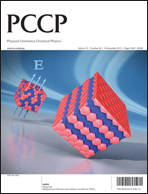Orientational relaxation in semiflexible dendrimers
Abstract
The orientational relaxation dynamics of semiflexible dendrimers are theoretically calculated within the framework of optimized Rouse–Zimm formalism. Semiflexibility is modeled through appropriate restrictions in the direction and orientation of the respective bond vectors, while the hydrodynamic interactions are included via the preaveraged Oseen tensor. The time autocorrelation function M(i)1(t) and the second order orientational autocorrelation function P(i)2(t) are analyzed as a function of the branch-point functionality and the degree of semiflexibility. Our approach of calculating M(i)1(t) is completely different from that of the earlier studies (A. Perico and M. Guenza J. Chem. Phys., 1985, 83, 3103; J. Chem. Phys., 1986, 84, 510), where the expression of M(i)1(t) obtained from earlier studies does not demarcate the flexible dendrimers from the semiflexible ones. The component of global motion of the time autocorrelation function exhibits a strong dependence on both degree of semiflexibility and branch-point functionality, while the component of pulsation motion depends only on the degree of semiflexibility. But it is difficult to distinguish the difference in the extent of pulsation motion among the compressed (0 < ϕ < π/2) and expanded (π/2 < ϕ < π) conformations of semiflexible dendrimers. The qualitative behavior of P(i)2(t) obtained from our calculations closely matches with the expression for Pexact2(t) in the earlier studies. Theoretically calculated spectral density, J(ω), is found to depend on the degree of semiflexibility and the branch-point functionality for the compressed and expanded conformations of semiflexible dendrimers as a function of frequency, especially in the high frequency regime, where J(ω) decays with frequency for both compressed and expanded conformations of semiflexible dendrimers. This decay of the spectral density occurs after displaying a cross-over behavior with the variation in the degree of semiflexibility in the intermediate frequency regime. The characteristic area increases with the increase in the semiflexibility parameter, where the expanded conformations of semiflexible dendrimers record the maximum characteristic area. For the compressed conformations the relative increment of this area is considerably lower than that of the expanded conformations of semiflexible dendrimers.


 Please wait while we load your content...
Please wait while we load your content...